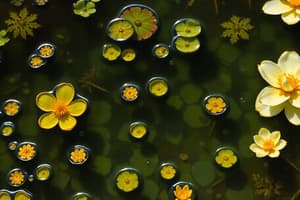Podcast
Questions and Answers
Explain the different types of water as habitats for microorganisms mentioned in the text.
Explain the different types of water as habitats for microorganisms mentioned in the text.
The different types of water habitats for microorganisms mentioned in the text are atmospheric water (rain, snow), surface water (rivers, streams, oceans, lakes), underground water (deep wells, springs), and stored water (stagnating water, ponds).
Discuss the ecological factors that influence aquatic microorganisms.
Discuss the ecological factors that influence aquatic microorganisms.
The ecological factors that influence aquatic microorganisms include dissolved gases (low oxygen diffusion, temperature, light, pH, nutrient concentrations, and depth and areal distribution.
What are the characteristics of aquatic microorganisms that enable them to adapt to aquatic environments?
What are the characteristics of aquatic microorganisms that enable them to adapt to aquatic environments?
Aquatic microorganisms have small size, ultramicrobacteria cells with a large surface area to intracellular volume ratio, and the ability to survive in oligotrophic conditions.
How do aquatic microorganisms contribute to the food chain and recycling of elements in aquatic environments?
How do aquatic microorganisms contribute to the food chain and recycling of elements in aquatic environments?
Explain the categories of freshwater habitats for microorganisms mentioned in the text.
Explain the categories of freshwater habitats for microorganisms mentioned in the text.
Flashcards are hidden until you start studying




